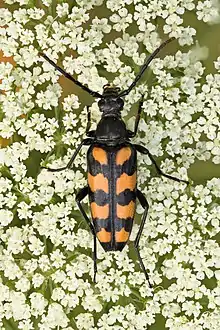Leptura quadrifasciata
Leptura quadrifasciata, the longhorn beetle, is a species of beetle in the family Cerambycidae. It was described by Carl Linnaeus in his landmark 1758 10th edition of Systema Naturae.[1]
| Leptura quadrifasciata | |
|---|---|
 | |
| Female | |
| Scientific classification | |
| Domain: | Eukaryota |
| Kingdom: | Animalia |
| Phylum: | Arthropoda |
| Class: | Insecta |
| Order: | Coleoptera |
| Infraorder: | Cucujiformia |
| Family: | Cerambycidae |
| Genus: | Leptura |
| Species: | L. quadrifasciata |
| Binomial name | |
| Leptura quadrifasciata | |
| Synonyms | |
| |
Adult beetles are 11–20 mm long, black with four more or less continuous transverse yellow bands. In extreme cases the elytra may be almost entirely black. It is found throughout the northern and central Palaearctic region.
The species is distributed in northern and central regions of Europe and Asia. It is particularly common in Scandinavia, Finland and Great Britain and is typically seen during the summer months.
Larvae make meandering galleries in various trees, including oak, beech, birch, willow, alder, elder and spruce; typically in dead and decaying wood, with a preference for damp areas. The life cycle lasts two or three years.[2][3]
References
- Linnaeus, C. (1758). Systema Naturae. 10th Edition. p. 398. Retrieved 26 August 2017.
- Svatopluk Bílý; O. Mehl (1989). Longhorn Beetles - Coleoptera, Cerambycidae - Of Fennoscandia and Denmark. p. 70. ISBN 9004086978. Retrieved 26 August 2017.
- "Four-banded Longhorn Beetle – Leptura quadrifasciata". naturespot.org.uk. Archived from the original on August 11, 2022. Retrieved October 2, 2023.
External links
Leptura quadrifasciata, Four-banded Longhorn Beetle at UK Beetles